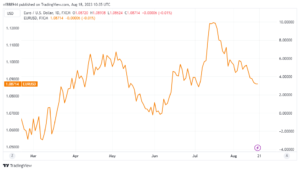EURUSD found some support near 1.0850.
The Euro (EUR) is trading inside a restricted trading range versus the US Dollar (USD). Causing EURUSD to hover around the 1.0870 zone. On Friday amid broad-based inconclusive trends in the risk-associated environment.
At the same time, the US dollar remains stable. However the multi-week surge appears to have hit a solid resistance region near 103.60 (August 16) when measured by the USD Index. The Dollar’s loss of traction is also consistent with the corrective decrease in US rates across various maturities.
In the broader context of monetary policy, there is fresh debate concerning the Federal Reserve’s position of sustaining a tighter policy for an extended length of time. This is due to the resiliency of the US economy, notwithstanding recent labor market weakening and lower inflation readings.
Internal differences exist within the European Central Bank (ECB) on the continuation of tightening measures after the summer period. These conflicts are leading the Euro to fall further.
In terms of economic data, the only noteworthy release was an increase in the eurozone’s final inflation rate. In the year to July, inflation was 5.3%, while the Core reading was 5.5%.
The euro appears unmotivated about 1.0870.
The EUR fluctuates against the USD at the end of the week, as investors remain concerned about China’s slow recovery.
In Japan, inflation was higher than expected in July.
Retail sales in the United Kingdom fell short of estimates last month.
Markets remain wary due to the Fed’s continuing tightening-for-longer narrative.
In the eurozone, inflation is sticky and substantially above the ECB’s objective.
Technical Evaluation: In the short term, the euro could experience additional losses.
Technical Outlook
In the event of more losses, EURUSD might retest the July low of 1.0833 (July 6) before retesting the important 200-day SMA at 1.0790, and finally fall below it. May’s low was 1.0635 (May 31). Further down, additional support levels can be seen around the March low of 1.0516 (March 15) and the 2023 low of 1.0481 (January 6).

In the meantime, bullish attempts are projected to encounter initial resistance around the August high of 1.1064 (August 10) before reaching the weekly high of 1.1149 (July 27). If the pair breaks through the latter, it may be able to relieve some of the downward pressure and potentially reach the 2023 peak of 1.1275 (July 18).
Once this zone is cleared, substantial resistance levels become less apparent until the 2022 high at 1.1495 (February 10), which is immediately followed by the round level of 1.1500. Furthermore, the EURUSD has a bullish outlook as long as it remains stable.









